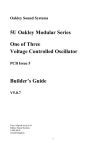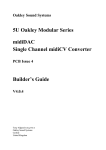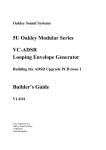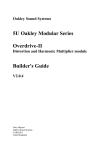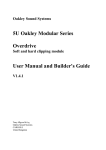Download Oakley Sound Systems The MultiMix PCB issue 4 User's Guide
Transcript
Oakley Sound Systems The MultiMix PCB issue 4 CV and Audio Mixer User’s Guide V4.5.0 Tony Allgood B.Eng Oakley Sound Systems CARLISLE United Kingdom The three variations of the Oakley Multimix. Each one is 1U wide by 5U high. Introduction The MultiMix is a highly useful utility module that can be obtained in three variations: MultiMix Sum The basic version of the MultiMix. This operates as a standard mixer. Up to three inputs, either CV or audio, can be summed or mixed together. The levels for each input can be set by a pot. The gain can be set from completely off to a little over one. Two mix outputs are available: One is +OUT and this is simply the three inputs added together according to the levels set by the pots. The other is -OUT and this is an inverted version of the signal at +OUT. This means if the output from +OUT is +4V, then the output from -OUT is -4V. A bicolour LED is also featured. This will glow when a signal is present at the outputs. The higher the output the brighter the LED. The colour of the LED will be determined by the output polarity. It will be red for mostly positive output voltages, and green for negative. MultiMix Standard This one is similar to the MultiMix Sum, but instead of ordinary pots to set the input levels, this one features three reversible attenuators. Each control knob can be set so that the gain of the input is anything from -1.1 to +1.1. This means that not only can inputs be added together, but can subtract as well. With each input knob set to its middle position, then none or very little of the input signal will reach the output. Mixer's with reversible attenuators on their inputs are very useful for controlling audio and CVs. One excellent application uses a MultiMix with a VCA to create a very flexible ring modulator. MultiMix Stooge This one is similar to the MultiMix Standard and has the three reversible attenuators controlling the input levels. However, this one features a clever combination of three output sockets to achieve a variety of uses. Inserting a jack into OUT1 and you will find a controlled version of the signal going into IN1. The pot will control the level of the signal as well as its phase. You can thus use this to attenuate, or invert, CV or audio signals around your modular. The other two input channels will work in a similar way. But if you don't utilise the OUT1 jack, then its output will automatically be summed with IN3 to form a mixed output at OUT3. Likewise, not using OUT2 will make its output join with the IN3 signal too. So you can use this module as a standard MultiMix if you don't use the OUT1 and OUT2 sockets. Although the three variants use different front panel designs, all are made from the same PCB. The different versions are simply selected by using different components and inserting some wire links into the board. The PCB The issue 4 MultiMix module features a two PCB set. Previously, many Oakley modules have had the sockets, switches and extra pots wired to the board by individual wires. The MultiMix allows all the socket wiring to be done via an extra PCB and two MTA or Molex KK solderless connections. If you are building this module in the standard MOTM and Oakley format this new system will reduce assembly time and possible wiring errors. Some people will wish to use this Oakley design in a non standard format, such as fitting it to a Analogue Solutions rack or one of their own invention. This is perfectly easy to do. Simply do not use the socket board and wire the main board to the sockets as per usual. I have provided space for the three control pots on the PCB. These can be mounted away from the PCB, but they can form part of the mounting process. If you use the specified pots and brackets, the PCB can be held very firmly to the front panel. Four M3 sized holes are provided on the PCB for supporting the board if you choose to use other methods of mounting. The pot spacing is 1.625” and is the same as MOTM modular synthesiser. The main board is fully MOTM panel compatible if the board is fitted vertically, ie. in a 1U wide panel. Please note that the sockets are mounted on a slightly different grid to the MOTM range. There are detailed instructions later in this document about how to build the boards. Circuit Description The MultiMix circuit is quite simple, but let’s run through the design carefully. Power is supply via the usual four way MTA or Molex connector. As is the custom for Oakley modules, I have used ferrite beads to act as high frequency filters on the power lines. Decoupling at the point of entry is provided by C15 for the positive rail, and C7 for the negative rail. Additional decoupling is also provided elsewhere on the board by the other capacitors shown. These capacitors keep the power supply clean of noise, and provide a reservoir for the little bursts of current that the circuit takes in normal operation. Two grounds are provided, one for the circuit itself, and one for the earthing of the jack sockets on the front panel. Note also the provision of six wire links on the board. These are to select which module variant is to be built. A full description of which link to fit for each variant is given in the parts list. There are six ICs, U1 to 6, on this PCB, and each requires power. The power supply to each IC is shown separately at the bottom of the schematic to avoid cluttering the main circuit pathways. All the ICs are simple dual op-amps and require both negative and positive supplies. Three of the inputs have identical ‘reversible attenuator’ circuits. In issue one and two of the Oakley MultiMix, I used a circuit that I found in the student engineers bible, The Art of Electronics by Horowitz and Hill. Now this little circuit is great. Its simple, cheap and works very well, but it does have one problem. That is, its input resistance changes as you turn the pot. In reality this has very little effect on the way you use your modular. However, being the perfectionist that I am I decided to do it differently in issue three. This has doubled the amount of op-amps in the circuit, but now we have a constant input resistance whatever the pots’ position. Issue 4 boards share the same improved input circuitry but there are some subtle changes to make the MultiMix more flexible. Let us consider the first reversible attenuator. This is connected to IN1 and has its output at OUT1. The circuit is made up from three op-amps. U1a (pins 1, 2, 3) acts simply as a voltage buffer. This is a circuit that merely ‘sniffs’ the input voltage and creates a copy of that signal at its output on pin 1. We are free to take a bucket full of current from this output without affecting the input at all. A bucket full of current must be defined here as anything less 15mA or so... U1b (pins 5, 6, 7) is a different circuit to the one around U1a. This is an amplifier with a gain of minus one. The negative bit means that its output is the opposite polarity to the input voltage. The input voltage is sensed by R7, and the current flowing through R7, is matched by an equal current flowing in R10. The op-amp does this because it adheres to the ‘golden rules’. Actually, it can only try to adhere to these golden rules. Now the golden rule in question is that an op-amp with negative feedback must move its output so that its two input pins are both the same voltage. The negative feedback is provided by the resistor R10. So as the input signal tries to inject current into the op-amps inverting (-) pin via R7, the output will move against this by taking that current away through R10. So a positive input voltage at R7 will lead to the output going negative. The ratio of the resistors will determine the gain of the inverting circuit. Making both the resistors the same value will mean that the gain of the op-amp is -1. That is 2V at the input gives us -2V at pin 7. As far as the connected input goes, it does not see what then happens to these two copies of itself. It only ‘sees’ the resistance of R7 and R1. Hang on, what's that R1 doing? Well R1 is only there to make sure that the input is not just floating in thin air with nothing attached. This is useful for when the circuit is not plugged in. Any stray static electricity cannot build up on this input and destroy the op-amp. Actually this is very unlikely, but it is good practice. R1 is of a high enough value so as not to affect the circuit sensitivity. R2 offers some sort of protection for U1a in any overvoltage situation. A typical example of this is trying to use the inputs when the MultiMix module is not powered up. Lets go back to our two copies of the input signal. Remember that one is an exact copy, and one is an inverted version. The exact copy firstly goes to a wire link switch, called LK1 and made from three solder pads. You simply solder a wire link between the middle pad and either one of its outer pads. It acts as a permanent switch built into the board when you populate the PCB. This ‘switch’ will connect the counter clockwise side of the LEVEL1 pot to either the output of U1a, the exact copy of our input signal, or to ground. Let us first assume that LK1 is joined between 1 and 3 and joins the pot with the op-amp output. We now have the two versions of the input signal placed across the two ends of the control pot. As the wiper moves from one side to the other, it will tap off a proportion of each signal. Consider what will happen with a +10V input signal at IN1. This will give +10V at the output of U1a and -10V at the output of U1b. The wiper of the pot can thus move from +10V to -10V. In the middle position, both voltages take equal precedence and the voltage at the wiper is zero. The voltage at the wiper is connected to another inverting amplifier based around U4a. The opamp’s gain is set to be -1.09. So a voltage of +10V at the wiper of the pot, will give +10.9V at the op-amp’s output. It is this output that drives the next section of the MultiMix circuit in the standard layout. In the ‘Stooge’ layout we use this output directly, and because of this the op-amp is configured for maximum stability Note that the gain is not set to be exactly -1. This is because many users desire the Multimix to be able to have a gain of exactly one, or unity, overall. This would be very difficult to achieve without trimmers because of the tolerances of the gain setting resistors. You would also have to allow for the possible loss of signal within the pots and that due to any output resistance of the connected source modules. The output resistance is an unknown quantity thus the overall gain would vary slightly depending on which module you connected up to the Multimix. However, by providing each stage with slightly more than unity gain it is still possible to dial up a gain of one with the front panel pots by backing them off slightly from their maximum position. C8 and R13 form part of the stabilising network designed to keep the op-amp from oscillating under capacitive loads. Capacitive loads are easily created in a patch cord synthesiser. Each patch cord acts as a low value capacitor to ground. This can make an op-amp very unhappy and its output will oscillate, often at very high frequencies. In issue 1 of the MultiMix, and many other modules, this stabilisation was simply achieved by a 1K resistor in series with the output load. However, this causes the output voltage to fall with increasing load. In the Stooge layout this would create increasing DC errors as more modules are connected the output. Issue 3, and now 4, resolved this matter, by using a more active approach using C8 and R13. A full explanation of their action is beyond the scope of this User guide, but more information can be found on the Analog Devices website in their Applications Note AN-257. I was first introduced to this method when I worked at Soundcraft, and have since used it on other many Oakley projects. Let us go back to LK1 again. Imagine now if the link was connected pads 2 and 3. This means that the output of U1a will be unused, and the pot’s counter clockwise pin will connected to ground. This is means that the pot’s wiper will now start from zero volts instead of the inverted version of the input. This is the mode used in the MultiMix Sum module. It allows each pot to act as a conventional level control and not as a reversible attenuator. U6b forms a summing amplifier. Currents flowing through all the input resistors, R29 and 30, come together at the inverting input. The op-amp’s output will alter to create the same current through R28. Since the value of all three resistors are the same the op-amp must produce the same voltage as presented at a single input. In other words, the gain of the summing stage is just over one. In fact, its actually minus one, since the output voltage is always an inverted sum of all the inputs. In the Standard and Sum modules this summing amplifier takes the outputs of the first two input channels directly and sums them together. It does this by the fitting of two further links, LK4 and LK5. In the Stooge module, things are a little more complex. U6b will sum the two outputs together but only if there are no jacks inserted into OUT1 and OUT2 on the front panel. This clever automatic switching is achieved by using the ‘normally closed’ (NC) contacts on the jack sockets. The links LK4 and LK5 are not fitted in this case, and a five way socket called OUT carries the outputs and the returning signals between the MultiMix circuitry and output boards. The output of U6b is fed directly into the output stage of the third input channel. Thus all three signals will be summed into this output, OUT3. Note that the inversion caused by U6b is nor corrected by the inverting nature of U6a. In the Standard and Sum versions of the MultiMix, the output of U6a will be the main +OUT. But these modules also feature an inverted output too. This is created by another inverting circuit complete with stabilising components. U5a and associating circuitry does the job. This circuit turns the summed voltage from U6a upside down. From the output of U5a we now have the main ‘-OUT’ signal and this needs to be passed to the appropriate socket on the front panel. This is done via a two way connection fitted into the bottom two pins of OUT, and by fitting a wire link into LK6 between pads 1 and 3. The Bicolour LED is a wonderful little thing. Its a simple design really, its just two LED chips of a different colour placed in the same clear package. Both LEDs are fitted in parallel, but the opposite way round. So the direction of current determines the colour seen. Because the LED is really a diode, it doesn’t switch on at any voltage. Each LED requires a certain voltage across the device for it to even glow dimly. In fact, different colours require different voltages. And too much voltage will kill them, permanently. If you connected the LED directly to a voltage source which was ramped up from 0 to +10V, the LED would at first be off, start to glow at about 2V and then probably get very bright very quickly. And then burn out with a final burst of brilliant light. (Ah! A short life, but a good one... and you’ve just seen 15 pence worth of semiconductor destroyed) The MultiMix connects the LED in the feedback path of an inverting op-amp amplifier, U5b. So any current going through the input resistor, R27, will be the same as the current in the LED and R26. Thus, the LED is controlled by current not voltage. The op-amp’s output will adjust automatically to create the correct voltage for a desired current. The LED can’t blow out as the opamp won’t supply that amount of current. The LED won’t be off at low levels of input voltage, because the op-amp always makes sure that even a little input voltage will create a little current. R27 controls the sensitivity of the circuit. 1K5 produces about 7 mA through the LED for a 10V output of the MultiMix. You may want to reduce this to 1K, to give a brighter reading. Personally, I think 7 mA is fine for most applications indoors. Another thing to bear in mind when you want a brighter LED, is that the current must come from somewhere. Both U5a’s output and U5b itself will have to provide this current, and both devices will protest if you try to take too much current out of them. Plus, you have to think about the power consumption of your modular itself. Too many pretty lights will start to demand too much of your power supply. In the Stooge version we have no inverted output or LED. So the whole of the circuitry surrounding, and including U5, can be omitted. Parts List For general information regarding where to get parts and suggested part numbers please see our useful Parts Guide at the project webpage or http://www.oakleysound.com/parts.pdf. The components are grouped into values, the order of the component names is of no particular consequence. A quick note on European part descriptions. R is shorthand for ohm. K is shorthand for kilo-ohm. R is shorthand for ohm. So 22R is 22 ohm, 1K5 is 1,500 ohms or 1.5 kilohms. For capacitors: 1uF = one microfarad = 1000nF = one thousand nanofarad. To prevent loss of the small ‘.’ as the decimal point, a convention of inserting the unit in its place is used. eg. 4R7 is a 4.7 ohm, 4K7 is a 4700 ohm resistor, 6n8 is a 6.8 nF capacitor. IMPORTANT NOTE: There are three different variations for this module. Make sure you get the right parts list. The Standard and Sum versions share the same parts list and differ only in the position of three links. The Stooge version requires a rather different parts list. MultiMix Standard and MultiMix Sum Variants Links These links can be made from component leg clippings or uninsulated tinned copper wire. Simply solder a small hoop of wire joining the relevant pads of each link. Note: for the ‘three pad links’ pad 1 is the square pad at one end, pad 3 is middle pad, and pad 2 is the round pad on the end. MultiMix Standard LK1, LK2, LK3 LK6 Link pads 1 and 3 Link pads 1 and 3 Link out LK4 and LK5. MultiMix Sum LK1, LK2, LK3 LK6 Link pads 2 and 3 Link pads 1 and 3 Link out LK4 and LK5. Resistors 5% 1/4W carbon or better. 75R 1K5 10K 15K 22K 24K R13, R23, R19, R16 R27 R2, R3, R6 R26 R15, R25, R22, R28, R30, R29 R14, R24, R20, R21, R18, R17 100K 470K R7, R10, R11, R8, R9, R12 R1, R4, R5 Capacitors 33pF low-K ceramic plate 100pF low-K ceramic plate 2u2, 63V electrolytic 100nF, 63V axial ceramic C8, C16, C10, C9 C17 C15, C7 C1, C2, C3, C4, C5, C6, C11, C12, C13, C14 Discrete Semiconductors 5mm Bicolour LED 1 off, fitted externally Integrated Circuits TL072 dual Bi-FET op-amp U1, U2, U3, U4, U5, U6 Miscellaneous 4-way 0.156” MTA header 5-way 0.1” MTA header 5-way 0.1” MTA housing 2-way 0.1” MTA header 2-way 0.1” MTA housing Leaded Ferrite beads LED clip/lens Sockets 50K lin Spectrol 248 Oakley-Spectrol Solder brackets PWR IN (Main PCB and I/O PCB) IN cable OUT (Main PCB and I/O PCB)**, LED OUT cable, LED cable L1, 2 LED Switchcraft APC112 LEVEL1, LEVEL2, LEVEL3 LEVEL1, LEVEL2, LEVEL3 1 off 2 off 2 off 3 off 4 off 2 off 1 off 5 off 3 off 3 off Around 2 m of insulated multistrand wire (26awg) ** The 2-way 0.1” header is fitted into pins 4 and 5 of the OUT location. You may well want to use 8-pin DIL sockets for the ICs. I would recommend low profile turned pin types as these are the most reliable. You need six of them. MultiMix ‘Stooge’ Variant Links These links can be made from component leg clippings or uninsulated tinned copper wire. Simply solder a small hoop of wire joining the relevant pads of each link. Note: for the ‘three pad links’ pad 1 is the square pad at one end, pad 3 is middle pad, and pad 2 is the round pad on the end. LK1, LK2, LK3 LK6 Do not fit LK4 and LK5. Link pads 1 and 3 Link pads 2 and 3 Resistors 5% 1/4W carbon or better. 75R 10K 22K 24K 100K 470K R13, R23, R19 R2, R3, R6 R15, R25, R22, R28, R30, R29 R14, R24, R20, R21 R7, R10, R11, R8, R9, R12 R1, R4, R5 The following parts are not fitted: R16, R17, R18, R26, R27 Capacitors 33pF low-K ceramic plate 2u2, 63V electrolytic 100nF, 63V axial ceramic C8, C16, C10 C15, C7 C1, C2, C3, C4, C5, C6, C11, C12, C13, C14 The following parts are not fitted: C9, C17 Integrated Circuits TL072 dual Bi-FET op-amp U1, U2, U3, U4, U6 U5 is not fitted. Miscellaneous 4-way 0.156” MTA header 5-way 0.1” MTA header 5-way 0.1” MTA housing Leaded Ferrite beads Sockets 50K lin Spectrol 248 Oakley-Spectrol Solder brackets PWR IN, OUT (Main PCB and I/O PCB) IN, OUT cables L1, 2 Switchcraft APC112 LEVEL1, LEVEL2, LEVEL3 LEVEL1, LEVEL2, LEVEL3 1 off 4 off 4 off 2 off 6 off 3 off 3 off Around 2 m of insulated multistrand wire (26awg) You may well want to use 8-pin DIL sockets for the ICs. I would recommend low profile turned pin types as these are the most reliable. You need five of them. Populating the Main MultiMix Circuit Board Occasionally people have not been able to get their Oakley projects to work first time. Some times the boards will end up back with me so that I can get them to work. The most common error with most of these was parts inserted into the wrong holes. Please double check every part before you solder any part into place. Desoldering and removing parts on a double sided board is a skill that takes a while to master properly. If you have put a component in the wrong place, then the best thing to do is to snip the component’s lead off at the board surface. Then using the soldering iron and a small screwdriver prize the remaining bit of the leg out of the hole. Then use wick or a good solder pump to remove the solder from the hole. Filling the hole with fresh solder will actually make the hole easier to suck clean! Sometimes people like to substitute parts in place of my own recommendations. Feel free to do this, but remember that there is normally a good reason why I have selected that particular part. If you do find that, say changing an op-amp with another one, makes an improvement, please do let me know either via the Oakley-Synths list or directly to me. All resistors should be flat against the board surface before soldering. It is a good idea to use a ‘lead bender’ to preform the leads before putting them into their places. I use my fingers to do this job, but there are special tools available too. Once the part is in its holes, bend the leads that stick out the bottom outwards to hold the part in place. This is called ‘cinching’. Solder from the bottom of the board, applying the solder so that the hole is filled with enough to spare to make a small cone around the wire lead. Don’t put too much solder on, and don’t put too little on either. Clip the leads off with a pair of side cutters, trim level with the top of the little cone of solder. Once all the resistors have been soldered, check them ALL again. Make sure they are all soldered and make sure the right values are in the right place. The axial multilayer ceramics can be treated like resistors. Simply bend their legs to fit the 7.5mm (0.3”) spacing holes. IC sockets are to be recommended, especially if this is your first electronics project. Make sure, if you need to wash your board, that you get water in and around these sockets. Also, make sure that any water drops left between the pins of the sockets are fully dried up before switching the board on. The smaller electrolytic capacitors are very often supplied with 0.1” lead spacing. My hole spacing is 0.2”. This means that the underside of these radial capacitors will not go flat onto the board. This is deliberate, so don’t force the part in too hard. The capacitors will be happy at around 0.2” above the board, with the legs slightly splayed. Sometimes you will get electrolytic capacitors supplied with their legs preformed for 0.2” (5mm) insertion. This is fine, just push them in until they stop. Cinch and solder as before. Make sure you get them in the right way. Electrolytic capacitors are polarised, and may explode if put in the wrong way. No joke. Oddly, the PCB legend marks the positive side with a ‘+’, although most capacitors have the ‘-’ marked with a stripe. Obviously, the side marked with a ‘-’ must go in the opposite hole to the one marked with the ‘+’ sign. Most capacitors usually have a long lead to depict the positive end as well. The 0.1” and 0.156” headers are fitted on the main board so that pin 1 is towards the top of the board. The clip on the side of the header will match with the picture on the PCB legend, ie. towards the location of the pots. For the Standard and Sum variations you need to use a 2-way header for the OUT interconnection. The header should be fitted so that it takes the bottom two places of the five holes on the main board. That is, you should make sure the top three holes that lie above the header are still visible. The Standard and Sum variants use pin 4 and 5 only. The Stooge version uses all five pins. I would make the main circuit board in the following order: resistors, IC sockets, small non-polar capacitors, electrolytic capacitors, and connectors. Then the final water wash if you have used solder with water based flux. Do not fit the pots at this stage. The mounting of the pots requires special attention. This will be covered later in this User Guide. Populating the Socket Boards You have one socket board to populate and the method is a little unusual. On the board the first things to solder are the headers. These are fitted to the BOTTOM of the board and are soldered from the top side. This is obviously opposite to what you are normally used to. The legending is on the top of the board, and the bottom of the board is marked as such in copper on the underside. Fit the INPUT header so that pin 1 is the square pin. The friction lock on the header should correspond to the legend on the top, ie. the opposite side, of the board. In other words the friction lock is facing the bottom of the module. The actual type of header used for the OUTPUTS interconnect will depend on the variation of the MultiMix you are building. If you are building the Stooge version, you will need to fit a five way header to OUTPUTS. This again is fitted on the bottom of the board like you have just done for the IN header. If you are building the Standard or Sum variant, then you need to take a little extra care when soldering the OUTPUTS header. You are using a two way header and it will be fitting into a location that seemingly has five pads. Three of these pads will not be used. This needs to be fitted so that you will utilise pins 4 and 5 of the header only. This means that pin 1 of the header itself should correspond to pin 4 on the board. In other words, you should fit the header so that the three pads, pins 1, 2 and 3, are still visible to the left of the fitted header. Remember that pin 1 on the board is designated with a square pad. The sockets will be fitted on the top of the board, and therefore be soldered on the bottom of the board. You may well find your own way of soldering the sockets, but the way I do it is as follows: Fit all your sockets into the board. The bevel edge should align with the picture on the board legending. Do not solder them at this stage. Take your front panel and align this over the sockets. Those of you building the Standard or Sum variant will not need to fit the socket labelled OUT1. Now carefully place your front panel with PCB and sockets upside down onto your bench [or kitchen table!]. The holes where the sockets will be should hang over the edge of the bench so that the sockets aren’t forced back up through the holes. You’ll also probably need a small counter weight to stop the panel from falling over the edge. Now allowing the PCB to rest flat on top of the sockets, you can begin to solder all the pins to the board. Those of you who have built older Oakley modules will be stunned how easy this was compared with the making of wire frames done previously. Mounting the Pots The first thing to do is to check your pot values. Spectrol/Vishay do not make it that easy to spot pot values. Your pot kit should contain: Value Marked as Quantity Location 50K linear M248 50K M 3 off Main PCB Fit the pot brackets to the pots by the nuts supplied with the pots. You should have two nuts and one washer per pot. Fit only one nut at this stage to hold the pot to the pot bracket. Make sure the pot sits more or less centrally in the pot bracket with legs pointing downwards. Tighten the nut up carefully being careful not to dislodge the pot position. I use a small pair of pliers to tighten the nut. Do not over tighten. Now, doing one pot at a time, fit each pot and bracket into the appropriate holes in the PCBs. Solder two of the pins attached to the pot bracket. Leave the other two pins and the three pins of the pot itself. Now check if the pot and bracket is lying true. That is, all four pins are through the board, and the bracket should be flat against the board’s surface. If it is not, simply reheat one of the bracket’s soldered pads to allow you to move the pot into the correct position. Don’t leave your iron in contact with the pad for too long, this will lift the pad and the bracket will get hot. When you are happy with the location, you can solder the other two pins of the bracket and then the pot's pins. Do this for both pots and snip off any excess wire from the pot's pins at this point. You can now present the front panel up to the completed board to check that it fits. If it does, then I mount the board up proper. You need to add the washer between the panel and the final nut. Again, do not over tighten and be careful not to scratch your panel. The pots shafts of the three pots will not need cutting to size. They are already at the correct length. The Spectrol pots are lubricated with a light clear grease. This sometimes is visible along the top of the mounting bush of the pot body. Try not to touch the grease as it consequently gets onto your panel and PCB. It can be difficult to get off, although it can be removed with a little isopropyl alcohol on cotton wool bud. Connections This is the bit where you connect the two boards, and possibly the LED, together. The boards have been designed to accept 0.1” headers for quicker manufacture. However, there is no reason why you cannot join the two boards together with hand soldered wire interconnects. MultiMix Stooge Variant Make up the first of two five way headers. The first should be made from wires 80 mm long. Make sure you get pin 1 going to pin 1 on the other housing, pin 2 to pin 2, etc. This cable carries the inputs to the MultiMix circuitry and should be connected to the INPUTS header on the I/O board and the IN header on the main board. The second and final lead is made up to be 130 mm long. This should connect the OUTPUTS header on the I/O board with the OUT header on the main board. If you get them the wrong way around the circuit won’t blow up, but it won’t work. MultiMix Sum and Standard Variants Make up one five way header. This should be made from wires 80 mm long. Make sure you get pin 1 going to pin 1 on the other housing, pin 2 to pin 2, etc. This cable carries the inputs to the MultiMix circuitry and should be connected to the INPUTS header on the I/O board and the IN header on the main board. The second lead is a two way interconnect. It is made up to be 130 mm long. This cable carries the two output signals. It will connect the OUTPUTS header on the I/O board to the OUT header on the main board. The third lead is another two way lead. Make this interconnect 130mm long. This will connect the LED to the main circuit board. The Molex Alternative to MTA For those of you who want to use the cheaper Molex system, the following information may be useful: A quick note on the female plugs; these are sometimes called housings, since they aren’t plugs themselves but merely housings for the individual crimp terminals. Terminals have to be bought in packs of one hundreds, but this is OK, because they are not expensive. These are normally designed to be crimped but they can be easily soldered with care. Make each wire the correct length. I normally strip back the wire by just 2 to 3mm. Place all the bare wire into the crimp on a heatproof surface. I use 12mm MDF board to protect my bench top, which although not at all burn proof will take plenty of heat from a soldering iron without major damage. Rest a pair of pliers on top of the wire to hold it in place. Slip the crimp under the wire, so that the wire’s insulation butts up to the edge of the terminal. Then solder in place. Sometimes I find I need to gently squash the crimp part of the terminal so that it will fit into the housing. This is easier to do before you solder it, although it can be done after with care. Do not use the water washable flux solder in this application. You must use either good old fashioned ersin or rosin flux based solders or the newer so called ‘no-clean’ types. I actually prefer the rosin based ones for this because I find they flow better. Once you have soldered it, wait a bit for it to cool, and then push it into the housing until it clicks. If it doesn’t go in, then take it out and bend the crimp slightly backwards. Now try again. I like to use as many different colour wires as possible. It makes wiring easier and looks great. And it also helps to make sure that pin 1 on one header is connected to pin 1 on the other. Power Connections The power socket is 0.156” Molex/MTA 4-way header. Friction lock types are recommended. This system is compatible with MOTM systems. Power +15V Module GND Earth/PAN -15V Pin number 1 2 3 4 As stated before the PAN pad on the PCB has been provided to allow the ground tags of the jack sockets to be connected to the powers supply ground without using the modules 0V supply. Earth loops cannot occur through patch leads this way, although screening is maintained. Of course, this can only work if all your modules follow this principle. Testing, testing, 1, 2, 3... Apply power to the unit making sure you are applying the power correctly. Check that no device is running hot. Any sign of smoke or strange smells turn off the power immediately and recheck the polarity of the power supply, and the direction of the ICs in their sockets. Assuming everything is OK so far, it is time to apply an audio input. Use a bright signal like a sawtooth output from a VCO. Middle A, 440Hz is a good note to use. Connect up an amplifier or mixing desk input to the OUT3 or OUT+ socket. Now connect your signal to the first input. You should be control the level with the top pot. If you have built the Standard or Stooge version, you should be able to silence the input by moving the pot to its middle position. If you have built the Sum version, the pot should act as an ordinary volume control. Input channels two and three should perform identically. If you have an LED, then this should glow when there is a signal present at the output. The larger the signal the brighter the LED. If you have built the Sum or Standard versions, check the OUT- socket. This should behave in the same way as the OUT+ socket. The output will be inverted but it should still sound the same. Stooge builders should now check the output from OUT1 and OUT2. OUT1 should be a controlled version of IN1, and OUT2 should be a controlled version of IN2. Inserting a jack plug into either OUT1 or OUT2 will cut the respective input from the OUT3 socket. Final Comments If you have any problems, an excellent source of support is the Oakley Sound Forum at Muffwiggler.com. Paul Darlow and I are on this group, as well as many other users and builders of Oakley modules. If you can't get your project to work, then Oakley Sound Systems are able to offer a 'get you working' service. If you wish to take up this service please e-mail me, Tony Allgood, at my contact e-mail address found on the website. I can service either fully populated PCBs or whole modules. You will be charged for all postage costs, any parts used and my time at 25GBP per hour. Most faults can be found and fixed within one hour, and I normally return modules within a week. The minimum charge is 25GBP plus return postage costs. If you have a comment about this builder's guide, or have a found a mistake in it, then please do let me know. But please do not contact me or Paul Darlow directly with questions about sourcing components or general fault finding. Honestly, we would love to help but we do not have the time to help everyone individually by e-mail. Last but not least, can I say a big thank you to all of you who helped and inspired me. Thanks especially to all those nice people on the Synth-diy, Oakley-Synths and Analogue Heaven mailing lists and those at Muffwiggler.com. Tony Allgood at Oakley Sound This User Guide was originally prepared in September 2005 Last Updated: October 2010 No part of this document may be copied by whatever means without my permission.





















